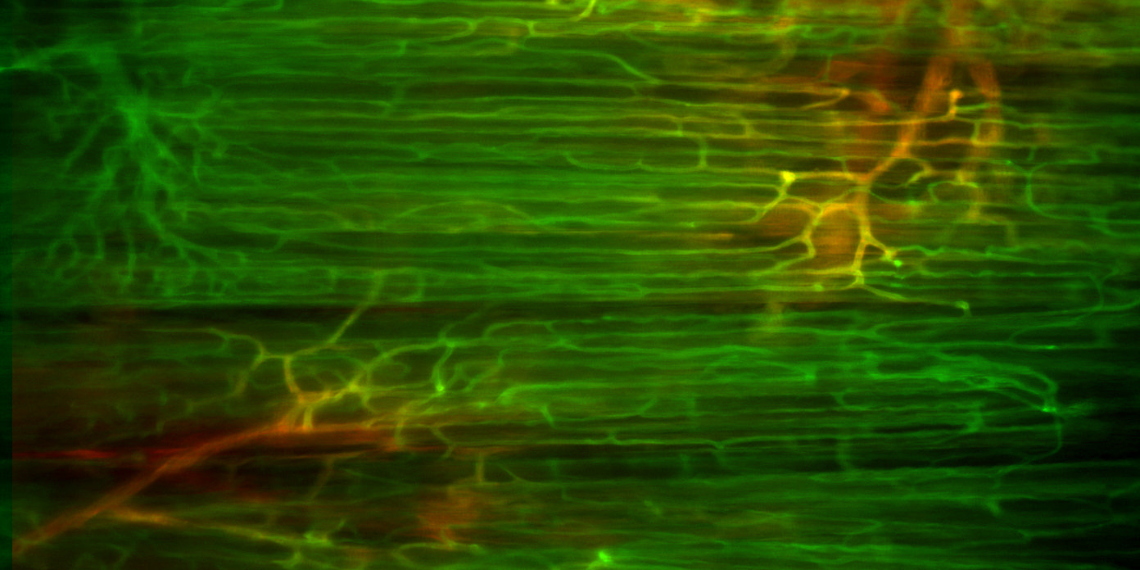Tiny Vessels, Big Impact: How Capillaries Control Blood Flow

How often do you think about blood? Unless you’re a vampire, probably only when you receive a minor injury like one of those pesky paper cuts. Paper isn’t the most sophisticated weapon, but it’s enough to sever your body’s smallest blood vessel: the capillary.
Researchers in the Department of Human Health and Nutritional Sciences are investigating how capillaries might have more roles in supporting our body’s health than we once thought.
 “Proper blood flow to every cell is critical for maintaining healthy tissues and a healthy body. For the longest time we’ve been operating under the assumption that larger blood vessels, like arteries, are the main players dictating blood flow,” says Dr. Coral Murrant. “What if it’s really the capillary?”
“Proper blood flow to every cell is critical for maintaining healthy tissues and a healthy body. For the longest time we’ve been operating under the assumption that larger blood vessels, like arteries, are the main players dictating blood flow,” says Dr. Coral Murrant. “What if it’s really the capillary?”
With only five litres of blood in the human body, blood distribution needs to be prioritized to certain organs or muscles – such as the stomach during digestion or specific groups of muscles during exercise. This is thought to occur through regulation of blood flow by arteries and their branches (arterioles), which is true for certain organs such as your stomach and intestines. But this model doesn’t fit with blood flow patterns needed to supply your brain and skeletal muscle.
“Sometimes a whole organ needs the same distribution of blood to the entire organ, like to your stomach during digestion. However, this isn’t how it works in skeletal muscle, where a few tiny muscle fibres may be active and need to receive blood while the ones directly adjacent do not,” explains Murrant.
Capillaries are thin-walled vessels with no ability to control their opening or closing (vasodilating or vasoconstricting) like arterioles can, which makes them ideal for nutrient and gas exchange between your blood and muscle. Given that each muscle fibre is surrounded by five capillaries, blood flow to specific capillaries could be delivering blood to very small microenvironments, such as a single muscle fibre. But how can these tiny vessels, which have no mechanism to physically alter blood flow themselves, exert this control?
Murrant’s lab has been at the forefront of investigating this phenomenon. Her lab is discovering the molecular signaling pathways that underlie capillary-to-arteriole communication, where capillaries can be stimulated by a contracting muscle fibre and then transmit information “upstream” to connected arterioles and arteries to deliver blood flow based on the needs of the tissue they supply.
One potential mechanism involves physical connections between endothelial cells. Endothelial cells, which make up the wall of the capillary, have small pores called gap junctions, which connect adjacent cells to one another. These junctions have long been a promising candidate as a mechanism underlying capillary-to-arteriole communication. However, the characteristics of gap-junction communication did not quite fit what was happening in skeletal muscle blood vessels, leaving researchers to seek out other signaling systems at play.
Murrant and former graduate student Iain Lamb had previously determined that an alternate signaling pathway called “pannexin/purinergic signaling” was involved in capillary-arteriole communication in muscle. What they didn’t know, however, was if this pathway is triggered during actual muscle contraction – a real-world physiological scenario when blood flow needs to be rapidly coordinated.
Using a thin muscle from a golden hamster that allows the capillaries and arteriole branches to be easily visualized and accessed, Murrant and Lamb were able to electrically stimulate a few muscle fibres to produce contractions under capillaries and then measure the response in the upstream arteriole.
Interestingly, they found that at high-contraction frequencies, the pannexin/purinergic signaling system was indeed the primary route of communication. Whereas at low-contraction frequencies, communication through gap junctions was dominant.
And more fascinating yet: when both of the above pathways were chemically inhibited at the same time, blood flow regulation still occurred, suggesting yet another pathway is involved in capillary-to-arteriole communication!
This may make you think about how your capillaries are communicating with your arterioles the next time you exercise. For example, if you are skipping rope and contracting your muscles quickly, you’re probably using the pannexin/purinergic system to ensure sufficient blood flow to your calf muscles. But if you are holding a yoga pose or doing a wall sit, you likely have the gap junction pathway to thank.
Murrant and her team are excited to continue its dive into the mysteries of capillary-based blood flow regulation in skeletal muscle, including how endothelial cells facilitate directional communication.
“We are just scratching the surface in this investigation of capillary-to-arteriole communication and how capillaries help get muscles the blood they need, when they need it. We are looking forward to plunging into this signaling mechanism and really getting down to understanding the real role of capillaries.”
Read the full study in the journal Physiological Reports.
Read about other CBS Research Highlights.